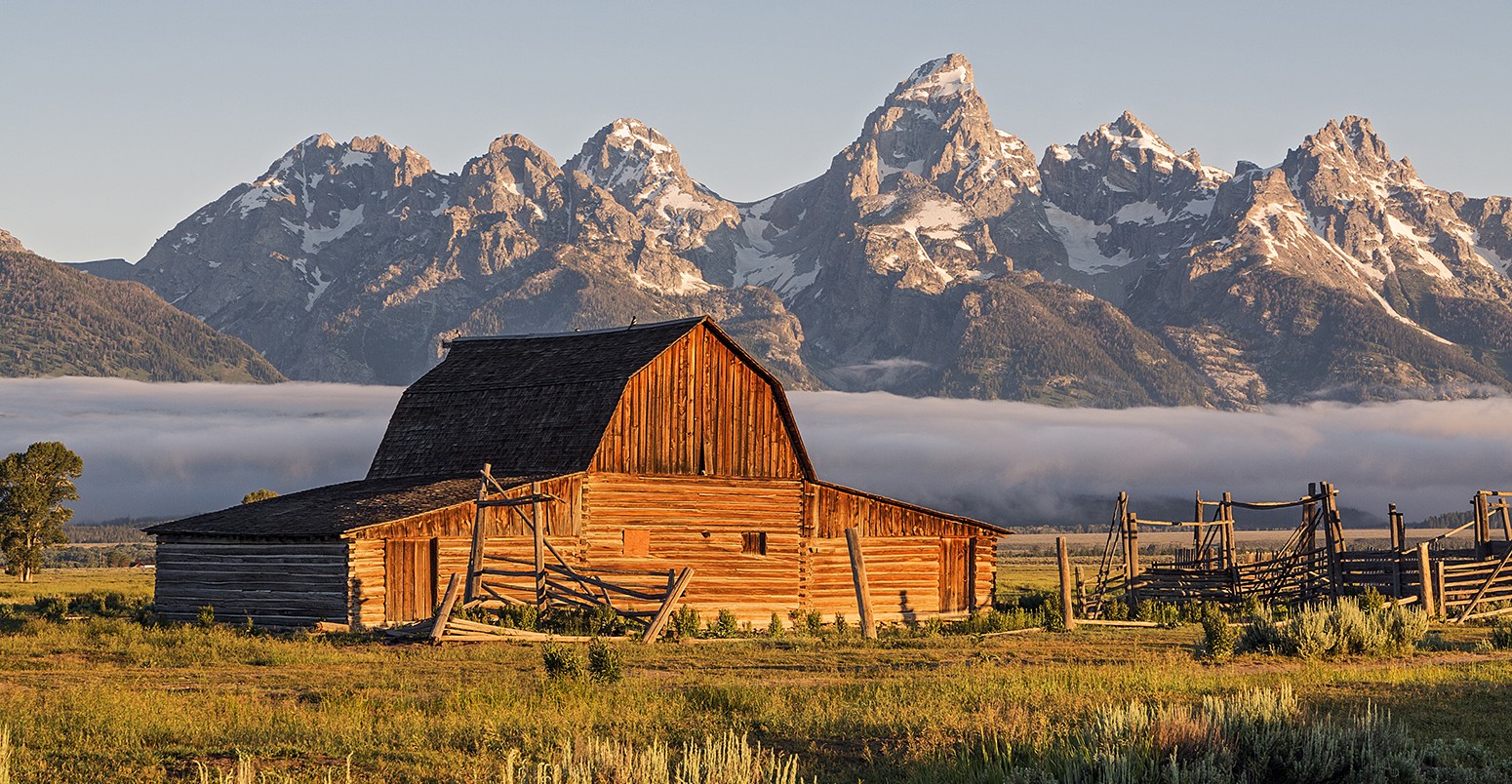Mountain shape a key factor in species surviving climate change
Robert McSweeney
05.20.15Robert McSweeney
20.05.2015 | 8:30amOne way animals and plants can cope with climate change is to relocate. Research shows some species are already shifting to higher ground or towards the poles in search of cooler climes.
But for creatures already living in mountains, the solution is not so simple. A new study of 182 high-altitude regions across the world shows how mountain shape is critical in determining whether a species will find refuge from rising temperatures further uphill.
This means the odds of survival are better for some species than others, say the authors.
Habitat range
The typical image of a mountain is a pyramid shape – a broad base that tapers to a peak. In theory, as species move upwards the habitat available to them shrinks, the paper explains.
But the study, published in Nature Climate Change, finds that over two-thirds of mountains don’t follow this rule. In fact, mountains fall into one of four shapes: diamond, pyramid, inverse pyramid and hourglass, as the diagram below shows.
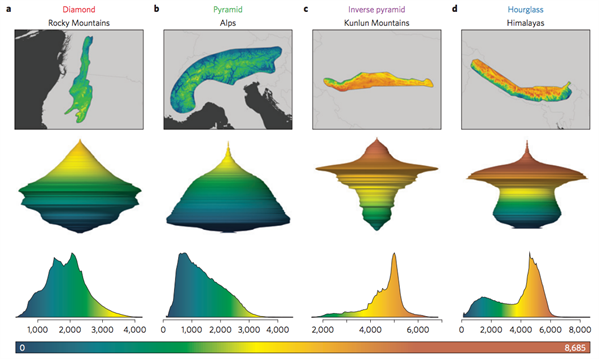
Examples of four common mountain types. Colours indicate elevation, from low (blue and green) to mountaintops (yellow and orange) Source: Elsen & Tingley (2015).
The most common mountain shape in the new study is the diamond (39%), followed by the traditional pyramid (32%), the hourglass (23%) and the inverse pyramid (6%).
Moving on up
The graphs below from the paper show how the amount of available habitat would change for each mountain type if global temperatures were 2C warmer than during a 1986-2005 baseline period.
You can see that while habitat decreases with elevation with the traditional pyramid, for other mountain shapes it increases (inverse pyramid) or plateaus before decreasing again (diamond and hourglass).
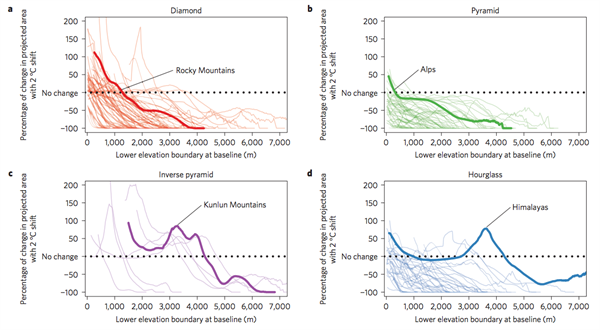
Percentage change in available habitat area for a mountain species moving uphill following a 2C temperature rise. Pale lines show individual ranges of that type. Bold lines are the examples in the earlier figure. Lines above (below) the dotted line show an increase (decrease) in habitat. Source: Elsen & Tingley (2015).
Winners and losers
The Himalayas are an hourglass mountain range. That means species living in its foothills will encounter a bottleneck as they move higher, squeezing their potential habitat, lead author Paul Elsen from Princeton University tells Carbon Brief.
The bird species Beautiful Nuthatch and Ward’s Trogon could face an increased risk of extinction if they moved to a higher elevation, for example.
However, for species already living in the narrow bottleneck, the potential habitat increases as they move to higher ground, Elsen notes.
You might recognise the rainbow-coloured Himalayan Monal as the inspiration behind the fictitious rare bird ‘Kevin’ in Pixar’s animated film ‘Up ‘ in 2009.
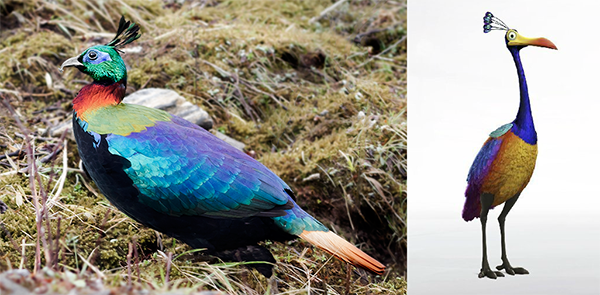
The Himalayan Monal was the inspiration behind ‘Kevin’ in the animated film ‘Up’. Credits: Monal (Dibyendu Ash) and Kevin (McBoo-Blitzman).
The Rocky Mountains, on the other hand, fall into the diamond category of mountain shapes. Species living in the foothills would find more habitat as they moved upwards towards the middle of the mountain, as long as they stop before it reaches its peak.
The Alps are a traditional pyramid shape, so species would find less available habitat as soon as they moved uphill, say the authors.
Mountaintops
But a species’ survival chances depend on more than mountain shape, the paper notes.
For truly mountaintop species, such as the snow leopard and alpine ibex, mountain shape won’t make any difference to future habitat because there’s no space to move higher. These species remain a high priority for conservation efforts, the researchers say.
For species that are living at ground level, they too will find their habitat diminishes once they move uphill, no matter what the shape of the mountain.
The overall height of a peak can plays a role in how much ‘refuge’ habitat it can offer to shifting species, says co-author Prof Morgan Tingley, from the University of Connecticut.
As temperatures keep rising, species will run out of comfortable habitat quicker in lower mountains than in higher ones, Tingley tells Carbon Brief:
However, for very large mountain ranges, getting to higher elevations may mean moving a long way, which not all species can manage, the paper notes.
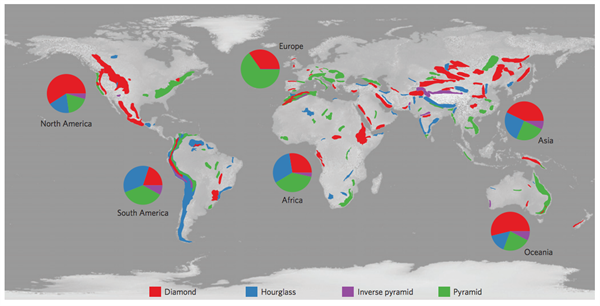
All four mountains types exist on every continent, except Europe, which only has pyramid and diamond mountains. Source: Elsen & Tingley (2015).
Conservation
The study’s findings could help target where mountain species are most threatened by climate change, say the authors. At-risk regions could then be first in line for conservation efforts, such as establishing a protected area or a biological corridor as a link to suitable habitat elsewhere. Elsen tells Carbon Brief:
Conservation priorities tend to focus on habitats that are isolated, rich in species, or home to very rare plants and creatures, the researchers say. But the new study suggests physical space is just as important for a species’ survival – a good argument for adding mountain shape to the priority list.
Main image: Sunrise at Moulton Barn in the Grand Teton National Park, Wyoming.
Elsen, P.R. and Tingley, M.W. (2015) Global mountain topography and the fate of montane species under climate change, Nature Climate Change, doi:10.1038/nclimate2656
-
Mountain shape a key factor in species surviving climate change
-
Research shows some species are already shifting to higher ground or towards the poles in search of cooler climes


